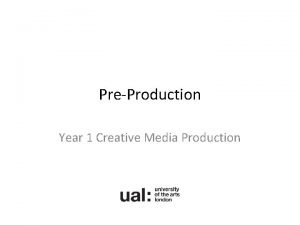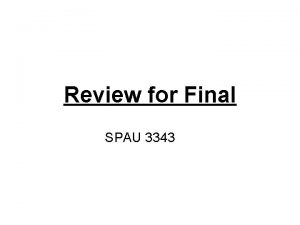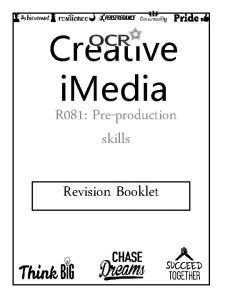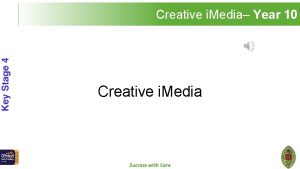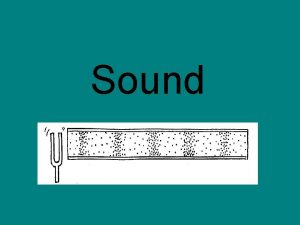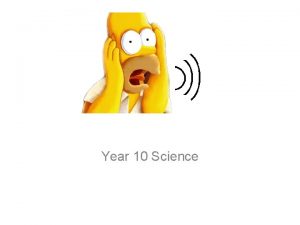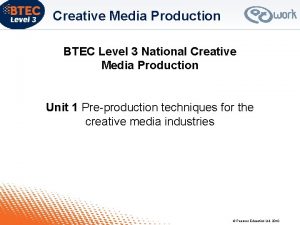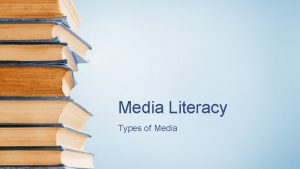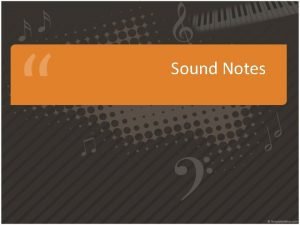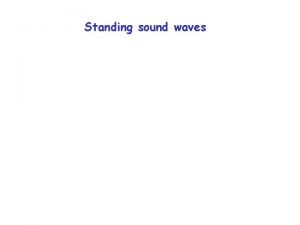Sound Year 1 Creative Media Production Types of














- Slides: 14

Sound Year 1 Creative Media Production

Types of Sound in Media Products

Types of Sound in Media Products DIEGETIC SOUND Any voice, musical passage, or sound effect presented as originating from a source within the Media Product’s world is diegetic. NON-DIEGETIC Any voice, musical passage, or sound effect that originates outside the Media Product’s world (such as the soundtrack) then it is non-diegetic OFFSCREEN SOUND Sounds from a source assumed to be in the space of the scene but outside what is visible onscreen. A good example of this the ambient sound of the city outside a hotel window – it can be heard but not seen. SONIC FLASHBACK Sound from one diegetic time is heard over images from a later time.

Types of Sound in Media Products SYNCHRONOUS SOUND Synchronous Sounds are all the sounds that their source of origin can be seen on-screen by the Audience. Synchronous Sounds are synchronized or matched with what is viewed on-screen by the Audience. For example, if the Media Product portrays a character playing the piano, the sounds of the piano are played in time with the image. ASYNCHRONOUS SOUND Asynchronous Sound is any sound or noise whose origin cannot be seen. Asynchronous Sounds are often not matched with a visible source of the sound on screen. Such sounds are included so as to provide an appropriate emotional nuance, and they may also add to the realism of the film. For example, a film maker might opt to include the background sound of an ambulance's siren while the foreground sound and image portrays an arguing couple to heighten the danger of the sequence.

Types of Sound in Media Products AMBIENT SOUND (also known as NATURAL SOUND or ROOM TONE) The background noise or hum in any given scene. When the sound of a crowd is heard (in the background) it is called a Walla. CONTRAPUNTAL SOUND These are sounds which do not easily fit or match with the images that they are layered over. This can often have quite a disorientating effect upon the Audience and can, sometimes, make them question what they are seeing.

Types of Sound in Media Products SOUND EFFECTS These are sounds which occur in the diegetic world of the Media Product and are used to amplify certain aspects of the action. A good example would be tyres screeching in a car chase sequence or the roaring of a Tyrannosaurus Rex in film such as Jurassic Park. These are also called Foley Sounds… We will discuss these some more later… PLEONASTIC SOUND Pleonastic sound is exaggerated sound such as the Light Sabers slashing the air in Star Wars or, the sound of a sword being drawn from its scabbard or, in a more genre driven context, the sound of a tap dripping more loudly than normal in a Horror film.

Putting it altogether. . . Screened Extract: Kill Bill Vol. 1 (Quentin Tarantino, 2003)

Diegetic/Non-Diegetic Sound Elle Driver enters the frame, accompanied by whistling and her Off-screen Diegetic footsteps. Because we cannot see Ellie whistling (as yet) this sound is, from a strictly academic perspective, Non-diegetic. As Ellie enters the hospital we hear Diegetic Ambient Sound of the hospital – people moving and talking. We can also hear the Offscreen Diegetic Sound of the rainfall. Whistling is still Non-Diegetic as we have yet to see Ellie’s face to confirm it is her whistling. Her Diegetic footsteps continue but are now no longer Off-screen Sound as we can see them. We can also hear her clothes rustle, making this sound a Pleonastic Sound Effect.

Diegetic Sound becomes Non-Diegetic The Non-Diegetic whistling and Off-screen Diegetic footsteps continue, with the Pleonastic Sound Effect of leather glove creaking amplified over the top. As she tightens her grip on the umbrella handle we hear the sound of thunder, an Off-screen Sound Effect. It is naturalistic and subtle so it is NOT Pleonastic. We finally see Ellie’s face and so confirms that Ellie is indeed whistling and so this sound now becomes Diegetic. More thunder rolls, again occurring as an Offscreen Sound Effect. Ellie’s whistling merges with the whistling on the Non-Diegetic soundtrack, technical making the Diegetic become Non. Diegetic. The sound of the door handle being opened is another example of Pleonastic Sound Effect. As the camera continues on down the corridor there is Ambient Sound and Sound Effects of the nurses’ footsteps layered beneath the Non. Diegetic soundtrack.

The Non-Diegetic Sound continues as the camera enters into The Bride’s hospital room. As the camera tracks in on her, Off-screen Diegetic Sound Effects are heard: the rain on the windows and the rubble of thunder, all signifying something ominous is going to happen. The Non-Diegetic Sound continues as the Split Screen occurs. While the Non-Diegetic Sound continues, Diegetic Sounds are overlaid of the various clothes being put on. These are Pleonastic to exaggerate them before the Audience. The Pleonastic Diegetic Sound of the drug filling the syringe amplifies the danger this represents to The Bride. . . Also the red colour helps to signify danger… The Non-Diegetic Sound goes really shrill and much more ominous when Elle Driver leaves the room in her disguise. . . Note that Ellie is not whistling so the whistling is definitely Non. Diegetic…

The Non-Diegetic Sound fades down as Driver approaches The Bride’s room. Evil intent is again signified by the Off-screen Diegetic Sound of thunder. The thunder gets louder as Ellie draws closer to The Bride’s room: this sound is a mirror of Ellie, a violent and dangerous moment that will kill The Bride. The Non-Diegetic Sound Effect accompanies the appearance of the text, emphasising its importance and potential violence. The sequence continues with purely Diegetic Sound. Note that there is the Off-screen Diegetic Sound Effect of the heart monitor playing throughout this scene…

Foley Sound The Boom Operator's job is to clearly record the dialogue, and only the dialogue. At first it may seem odd that the sounds the Boom Operator’s tried to exclude are added back. But, by doing this, the director has much greater control over the sound and its aural effect: by excluding these sounds during filming and then adding them in Post Production, a Director has greater control over the timing, quality, and relative volume of the sound effects. Foley Sound are Sound Effects that are added to the film during post production. They include sounds such as footsteps, clothes rustling, crockery clinking, paper folding, doors opening and slamming, punches hitting, and glass breaking.

Voice Over When a voice, often that of a character in the film, is heard while we see an image of a space and time in which that character is not actually speaking. The voice over is often used to give a sense of a character's subjectivity or to narrate an event told in flashback. It is overwhelmingly associated with genres such as film noir, and its obsessive characters with a dark past. It also features prominently in most films dealing with autobiography, nostalgia, and literary adaptation.

Sound Bridges can lead in or out of a scene. They can occur at the beginning of one scene when the sound from the previous scene carries over briefly before the sound from the new scene begins. Alternatively, they can occur at the end of a scene, when the sound from the next scene is heard before the image appears on the screen. Sound bridges are one of the most common transitions in the continuity editing style, one that stresses the connection between both scenes since their mood (suggested by the music) is still the same.
 Pengertian post production
Pengertian post production Recce imedia
Recce imedia What is mass communication
What is mass communication Primary school year 6 leavers poem
Primary school year 6 leavers poem What is airstream mechanism
What is airstream mechanism “a sound mind is in a sound body”
“a sound mind is in a sound body” What is sound
What is sound Creative strategies in social media marketing
Creative strategies in social media marketing Ocr creative media
Ocr creative media Creative i media revision
Creative i media revision Media and creative studies
Media and creative studies Conventions of text types
Conventions of text types Media production architects
Media production architects Videoipath
Videoipath The virtuoso h264
The virtuoso h264

